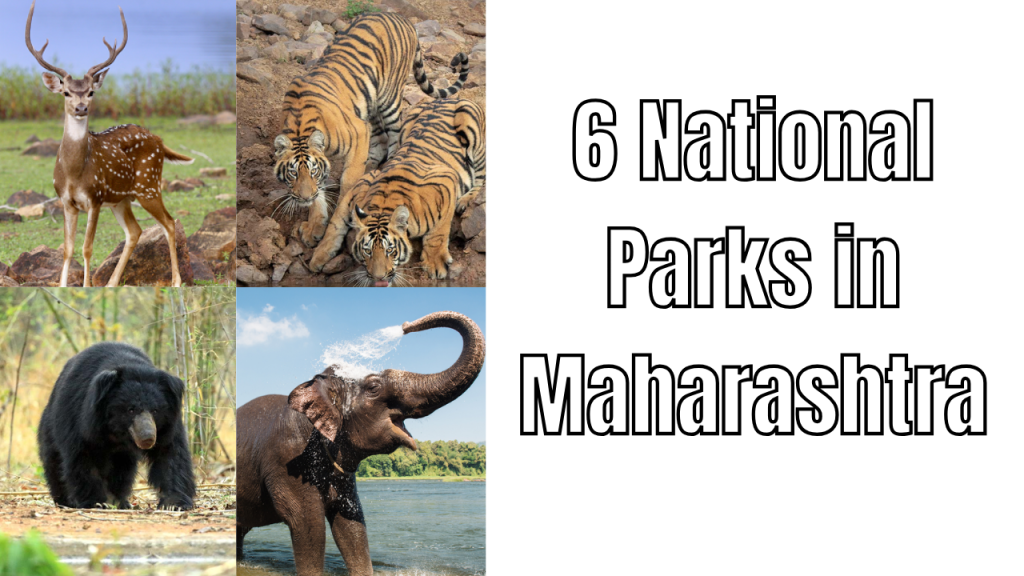
Maharashtra, a state known for its rich cultural history and diverse landscapes, is also home to several magnificent national parks that serve as sanctuaries for wildlife and nature enthusiasts. These parks, spread across expansive areas, showcase the state’s natural beauty while providing safe havens for a remarkable variety of flora and fauna.
The region’s landscapes vary from dense forests to vast grasslands, all of which are home to an incredible array of wildlife, including elusive big cats, majestic herbivores, and a host of bird species. Let’s take a closer look at six of the most significant national parks in Maharashtra, ranked from the largest to the smallest.
Tadoba Andhari Tiger Reserve
Tadoba Andhari Tiger Reserve, located in the Chandrapur district of Maharashtra, holds the distinction of being the largest national park in the state, covering an area of about 623 square kilometers. This vast reserve is renowned for its high tiger density, making it one of the most prominent tiger reserves in India.
The reserve is part of the Tadoba-Andhari Wildlife Sanctuary and is home to a diverse range of species, including leopards, wild boars, and the Indian bison. The park is also a haven for birdwatchers, with several species of birds calling it home. Visitors to Tadoba Andhari have a good chance of spotting the elusive tiger in its natural habitat, along with other wildlife that roams freely across the park’s rugged terrain.
The park’s dense forests, open meadows, and water bodies offer a variety of ecosystems, making it an ideal habitat for a wide range of species. The park also plays an important role in wildlife conservation efforts, with active initiatives to protect endangered species and promote sustainable eco-tourism practices. Tadoba Andhari is a must-visit destination for those seeking to witness the majesty of tigers and the untamed beauty of Maharashtra’s wilderness.
Gugarnal National Park
Situated in the Amravati district, Gugarnal National Park covers an area of approximately 361.28 square kilometers. It forms part of the Melghat Tiger Reserve, a key area for tiger conservation. The park is known for its rugged topography, dense forests, and diverse wildlife. Gugarnal is home to several species, including tigers, leopards, Indian bison, and a variety of deer. The park’s flora consists of tropical dry deciduous forests, which are an essential part of the local ecosystem.
Visitors to Gugarnal National Park can enjoy the pristine beauty of the forests, which offer an array of hiking and wildlife-watching opportunities. The park is particularly famous for its efforts in preserving the tiger population and maintaining the delicate balance of the forest ecosystem. The combination of rich wildlife, diverse landscapes, and its role in conservation makes Gugarnal a significant destination for wildlife tourism in Maharashtra.
Chandoli National Park
Chandoli National Park, located in the Satara district, covers an area of approximately 317.67 square kilometers. The park is well-known for its lush green forests, scenic views, and a rich diversity of flora and fauna. It serves as an important biodiversity hotspot, with a variety of wildlife species inhabiting the park, including the endangered Indian Giant Squirrel, which is one of its most notable residents.
Chandoli National Park is part of the Sahyadri Tiger Reserve, a UNESCO World Heritage Site, which enhances its significance in wildlife conservation. The park’s topography, marked by steep hills and deep valleys, provides a unique habitat for wildlife, and its natural beauty makes it a peaceful retreat for nature lovers.
Pench National Park
Pench National Park is a unique and vast reserve that spans two states—Madhya Pradesh and Maharashtra. The Maharashtra part of the park covers approximately 257 square kilometers and is a key area for tiger conservation. Named after the Pench River that flows through its heart, this park is immortalized by Rudyard Kipling’s famous novel The Jungle Book, which was inspired by its landscapes and wildlife.
Apart from the large carnivores, Pench is also home to a wide variety of birds, reptiles, and smaller mammals. Visitors can enjoy jeep safaris that offer the chance to observe wildlife in its natural setting. Pench National Park is also a popular destination for nature and wildlife photography, due to the abundance of wildlife and the park’s beautiful scenery.
Navegaon National Park
Located in the Gondia district, Navegaon National Park covers an area of approximately 133.9 square kilometers. It is a picturesque park, known for its serene landscapes, tranquil lakes, and abundant birdlife, making it a haven for birdwatchers. The park’s forested areas are home to a variety of wildlife, including tigers, leopards, and several species of deer. However, it is the numerous species of birds that make Navegaon particularly special.
The park also has a reservoir that adds to its charm, offering a scenic environment for visitors to relax and enjoy the peaceful surroundings. With its mix of natural beauty and rich birdlife, Navegaon is a hidden gem for those seeking a quieter wildlife experience.
Sanjay Gandhi National Park
Despite being relatively small compared to the other national parks on this list, Sanjay Gandhi National Park, located in Mumbai, is one of the most visited parks in the world, attracting millions of visitors every year. Covering approximately 87 square kilometers, it is an urban oasis in the bustling city of Mumbai, offering a tranquil escape from the urban chaos.
What makes Sanjay Gandhi National Park particularly unique is its location within one of the most populous cities in the world. The park’s accessibility makes it a popular destination for city dwellers seeking a connection with nature. Despite its relatively small size, the park plays an essential role in preserving local biodiversity and provides ample opportunities for hiking, birdwatching, and wildlife photography.